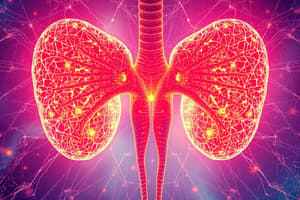Podcast
Questions and Answers
What are the two main types of adrenal hormones?
What are the two main types of adrenal hormones?
Steroid hormones and non-steroid hormones
How do steroid hormones interact with cells?
How do steroid hormones interact with cells?
They can penetrate cell membranes and bind to specific receptors.
What is the role of non-steroid hormones in cell interaction?
What is the role of non-steroid hormones in cell interaction?
Non-steroid hormones require a carrier protein to transport them across the cell membrane and bind to receptors.
What are the main parts of the adrenal glands?
What are the main parts of the adrenal glands?
What are the symptoms of the fight-or-flight response?
What are the symptoms of the fight-or-flight response?
What is the role of hormones in communication and coordination between different body parts?
What is the role of hormones in communication and coordination between different body parts?
How do steroid hormones interact with cells?
How do steroid hormones interact with cells?
What is the function of the adrenal medulla?
What is the function of the adrenal medulla?
How do non-steroid hormones initiate a cellular response?
How do non-steroid hormones initiate a cellular response?
Which part of the adrenal glands is responsible for regulating electrolyte and water balance?
Which part of the adrenal glands is responsible for regulating electrolyte and water balance?
Flashcards are hidden until you start studying
Study Notes
- The sympathetic nervous system is one of two systems responsible for communication and coordination between different body parts, achieved through the release of hormones.
- Hormones are produced in the adrenal glands and travel in the bloodstream to reach various body parts.
- Hormones can impact only targeted cells, known as receptive cells.
- There are two main types of adrenal hormones: steroid hormones derived from cholesterol and non-steroid hormones derived from amino acids or proteins.
- Steroid hormones can penetrate cell membranes and bind to specific receptors, triggering a series of reactions within the cell.
- Non-steroid hormones require a carrier protein to transport them across the cell membrane and bind to receptors, initiating a response.
- The adrenal glands consist of several main parts: the adrenal cortex (under the adrenal gland cap) and the adrenal medulla.
- The adrenal cortex produces hormones that regulate various body functions, such as the production of steroid hormones and the regulation of electrolyte and water balance.
- The adrenal medulla produces catecholamines, which act as the second messenger for the sympathetic nervous system and contribute to the fight-or-flight response.
- The symptoms of the fight-or-flight response include increased heart rate, blood pressure, respiration rate, and release of glucose into the bloodstream to provide energy for the body.
- The adrenal glands also play a role in regulating the body's response to stress and in the regulation of water and mineral balance.
- The adrenal glands also release cortisol, a hormone that helps regulate metabolism and responds to stress, and aldosterone, a hormone that helps regulate the balance of fluids and electrolytes in the body.
Studying That Suits You
Use AI to generate personalized quizzes and flashcards to suit your learning preferences.




